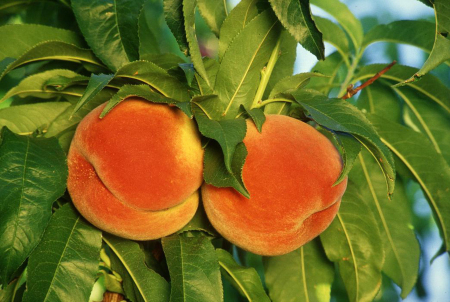http://www.theledger.com/article/20120314/NEWS/120319570
Some Former Citrus Growers Turn to Peach Farming
 SCOTT WHEELER | THE LEDGER
SCOTT WHEELER | THE LEDGER
Sean Harper thins out the peaches on his trees at SunSweet Peaches in Bartow recently.
By Elvina Nawaguna
THE LEDGER
Published: Wednesday, March 14, 2012 at 11:31 p.m.
Last Modified: Wednesday, March 14, 2012 at 11:31 p.m.
BARTOW | White bucket in hand, Sean Harper walks down a row of peach trees, thinning out immature fruit a few weeks ahead of harvest. Just four years ago, this land was covered in a citrus grove. But on this sunny mid-morning, not one orange tree remains.
"I just got tired of dealing with the freezing and the greening and the canker," he said, plucking a small peach from a tree.
Like many Florida citrus farmers, the uncertainty caused by the citrus diseases and previous freezes caused him to turn to peach farming.
"We had a cold snap for one or two days and we lost about 60 percent of our fruit," the owner of SunSweet Peaches said. "We didn't want to plant it again. It was still too risky."
He estimated that his citrus losses from the freeze could add up to nearly $200,000.
Jacqueline Burns, director of University of Florida's Citrus Research and Education Center in Lake Alfred, said citrus greening and canker have plagued commercial citrus growers all over the state and made growing the fruit too expensive for some.
The Asian citrus psyllid was first detected in Florida in 1998, according to the Florida Department of Agriculture. The citrus greening disease then showed up in Miami-Dade County in 2005 and later in other areas of the state, including Polk, in 2007.
"The cost of managing citrus has increased because of the extra precaution taken to grow the crop," Burns said.
Some citrus growers, she said, are buying new land to start growing peaches or are turning some of their groves into peach orchards.
"There's disease pressure, but there's also business pressure," Burns said. "Growers might think, If I can't productively and sustainably grow citrus, what else can I do?'"
With the University of Florida now producing peach varieties that can grow in Florida's sub-tropical climate, peaches have become an alternative for citrus farmers who want to diversify and spread their risk.
"I think they're seeing the writing on the wall that they can't have all their eggs in one basket," said Mercy Olmstead, an extension specialist for stone fruit production with University of Florida's Department of Horticultural Sciences in Gainesville.
The school has come up with "low chill" varieties of peaches that don't require as many cold days to produce fruit like more northern trees do and can survive Florida's mostly subtropical climate.
Although growing peaches is usually associated with Georgia, peach farming is not entirely new to Florida. According to Olmstead, Florida had about 5,000 planted acres of peach trees in the early 1980s, but a devastating freeze in the mid-80s caused a drastic drop to about 500 acres by the end of that decade.
Florida peach farming only started to pick up again about a decade ago, she said. Today, there are more than 1,000 planted acres of peach trees, mostly in Central and South-central Florida, compared to 240 acres reported in 2007.
Georgia has about 12,000 acres.
About a quarter of Florida's orchards are producing their first fruit this year when harvest starts in April, according to Olmstead. A peach tree takes about a year to produce its first fruit and up to three years to be in full production.
Although the U.S. Department of Agriculture still doesn't track Florida's peach production, Olmstead said the industry will keep growing and expects at least a 15 percent increase in production this year from 2011.
Sterling Ivey, a spokeswoman for Florida Department of Agriculture and Consumer Services, said the best definitive information on Florida peach production will come out in a USDA Census report that will be released in February 2014.
"However, there are indications through occasional reports that peach production continues to expand," Ivey said. "We estimate in the next three years we'll see a massive increase in production acres, which currently remains far less of the number of acres dedicated to citrus.
This will be Harper's second harvest. He planted his first 10 acres of peach trees in the spring of 2010 and sold most of his first fruit through a "you-pick" last year, charging the public about $1.50 per pound picked.
Over the last two years, SunSweet Peaches planted 15 more acres and plans to have a total of 40 acres planted. Harper expects to harvest 40,000 pounds of peaches, up from 15,000 pounds last year, and is in talks with a few grocery stores to start selling his fruit commercially.
The advantage with growing peaches in Florida, he said, is that the peaches hit the market two months before Georgia and California and can enjoy a market with little competition. Currently, Florida peaches are mostly sold within the state and neighboring states.
Andrew Meadows, director of communications at Lakeland-based Florida Citrus Mutual, said the organization is aware of citrus farmers diversifying to peaches.
"We're not concerned that we're losing citrus growers at this point," he said, adding that the peach growing industry is still in such an infant stage that it doesn't significantly affect the citrus industry.
"Anytime growers can broaden their portfolio and have an option in addition to citrus, that's a positive thing," Meadows said. "It's just smart business not to put all your (oranges) in one basket."
[ Elvina Nawaguna can be reached at
Elvina.Nawaguna@theledger.com or 802-7515. ]
 SCOTT WHEELER | THE LEDGER
SCOTT WHEELER | THE LEDGER
The advantage with growing peaches in Florida, Sean Harper said, is that the peaches hit the market two months
before Georgia and California and can enjoy a market with little competition. Currently, Florida peaches are mostly
sold within the state and neighboring states. 







